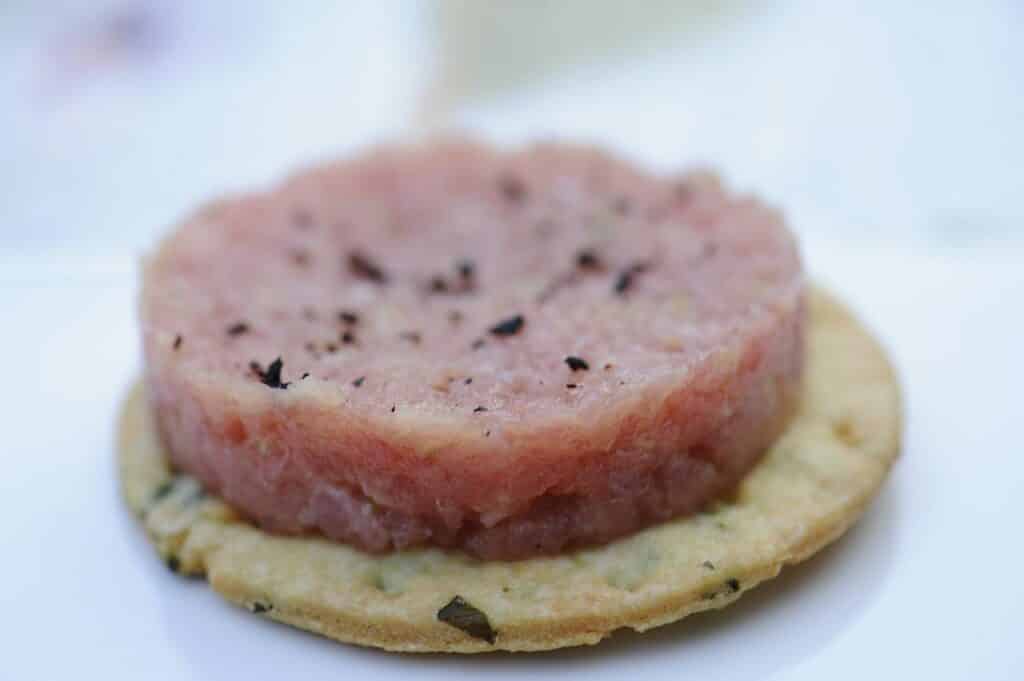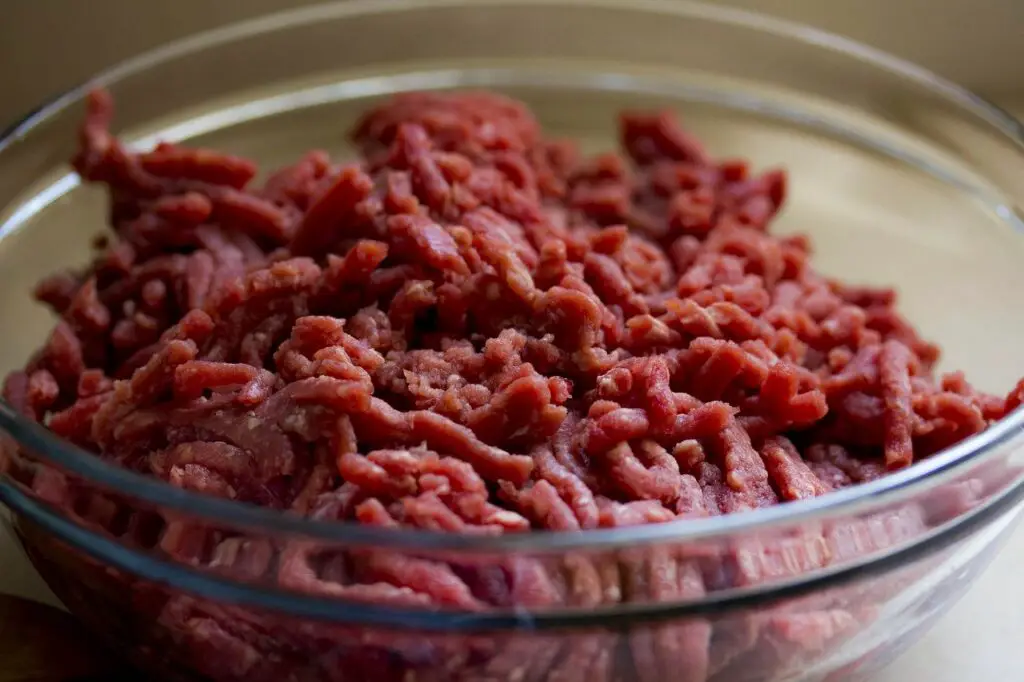Ground beef is an excellent source of protein and healthy fats, and you probably use it for many meals, especially when making meatloaf, lasagna, meatballs, or burgers.
Do you often wonder if your dog can eat the remaining raw ground beef after making a hearty meal?
We are here to set the record straight.
So, can dogs eat raw ground beef?
No.
Raw ground beef is prone to bacterial contamination, putting your canine at significant risk of salmonella.
Salmonella poisoning causes gastrointestinal distress in dogs.
Other dangerous contaminants in raw ground beef that pose a substantial threat to your dog are E. coli and Listeria.
Let’s look into why it’s not a good idea to feed your dog raw ground beef, symptoms to look out for in case of infection, and safer alternatives.

Risks of feeding your dog raw ground beef
It may be tempting to give your dog raw ground beef to mimic what they would have eaten in the wild.
Some dog owners prefer the raw food diet for their furry friends, which eventually may cause more harm since pets are domesticated.
Raw ground beef may contain salmonella, listeria, and E. coli which are easily eliminated by cooking as high temperature kills the bacteria.
These infections can quickly spread to other pets and humans in the household when your pet licks people, contaminates common surfaces, or through the feces.
These bacterias have the following effects on your canine:
Salmonella
Salmonella infection is known as salmonellosis in dogs.
Younger developing pups with higher dietary requirements to boost growth and older dogs with weaker immune systems are more likely to get salmonellosis when they ingest contaminated raw ground beef.
The health condition of your dog is also a significant factor as unhealthy and malnourished pets stand a higher chance of infection.
If left untreated, salmonellosis can kill a high-risk dog.
One of the initial symptoms of salmonellosis is bloody or mucousy diarrhea and lethargy.
Other symptoms to look out for are:
- Fatigue
- Weakness
- High fever
- Loss of appetite
- Vomiting
- Dehydration
- Decreased activity
Listeria
Listeria can be found in raw ground beef and can even spread to other foods in the refrigerator.
Cooking eliminates the bacteria in the raw ground beef due to extreme heat.
Listeria infection in dogs, known as listeriosis, is dangerous as it can cause meningitis which inflames the membranes covering the spinal cord and brain.
Symptoms of listeria infection in dogs are:
- Diarrhea
- Vomiting
- Nausea
- Weakness high fever
- Lethargy
- Stiff neck
- Lack of coordination
- Sore muscles
E. coli
Escherichia coli or E. coli affects weak, old, young, malnourished, or unhealthy dogs.
A dog with E. coli can pass the bacteria to other pets and people in the household.
E. coli causes colibacillosis disease in dogs.
Symptoms to look out for include:
- Diarrhea
- Vomiting
- Loss of appetite
- Depression
Parasites
Raw ground beef may expose your four-legged friend to parasitic infections.
Your dog is at risk of getting tapeworms and protozoal transmissions.
Contact the vet for medical intervention if you suspect your furry friend has parasites, Listeria, E. coli, or salmonella from ingesting raw ground beef.

Safer and healthier alternatives for your dog
A wholesome diet for your dog should include meat, vegetables, fruits, grains, and legumes.
It’s best to cook meat before feeding your furry friend to avoid the risk of infection.
However, your four-legged buddy can eat raw vegetables and fruits that have been washed to remove dirt and residues.
Healthy foods that you can feed your dog are:
Meat: Cooked ground beef or chicken, lean pork, beef steak, turkey, and rabbit are samples of meat that you can feed your fur buddy. Always ensure the meat is well cooked.
Vegetables: You can include kale, spinach, broccoli, carrots, green beans, and cucumber in your dog’s diet. Vegetables are an excellent source of vitamins and other minerals and boost your dog’s health and immune functions.
Fruits: Your furry friend will enjoy apples, peaches, pears, pineapples, and mangoes. Ensure the fruits are cored and peeled for your canine’s safety. Remove the pits from peaches as they are a choking hazard. Fruits are full of nutrients and antioxidants and are a healthy choice.
Legumes and grains: Legumes and grains are packed with carbohydrates, protein, fiber, and other vital nutrients that promote good health in your canine. Samples to try are beans, peas, lentils, brown rice, oats, and sorghum.
Healthy cooked ground beef recipe for your dog
It may not be a good idea to feed your dog raw ground beef.
On the other hand, cooked ground beef makes quite a nutritious and tasty meal for your furry friend.
Ground beef and sweet potato recipe
Ingredients
- 500g ground beef
- One large carrot or two small ones
- One large sweet potato
- Half a tablespoon of coconut oil
Instructions
- Wash, peel, and dice your carrot and sweet potato.
- Put your pot on medium heat and add the coconut oil.
- Add the ground beef and cook until it’s no longer pink.
- Put the diced carrot and sweet potato and add some water.
- Allow the food to boil for 20 minutes on medium heat.
- Stir to ensure it’s well cooked, remove from fire and allow to cool.
- Serve your furry friend a warm meal.
Storage
You can store the left-over meal in the fridge for up to five days.
You can also freeze the meal in an airtight container for two months.
Benefits
The ground beef and sweet potato recipe is rich in protein, vitamins, and minerals like zinc, iron, and selenium from the meat.
The carrots and sweet potatoes have fiber, vitamins, carbohydrates, and beta-carotene, making it a healthy and wholesome meal for your fur buddy.

Conclusion
It may seem natural for dogs to eat raw meat like their wild relatives in the forests, but dogs are highly domesticated and are used to a different diet.
Raw ground beef exposes your furry friend to many health risks and is best served cooked to avoid infections and disease.
Always ensure your canine enjoys a wholesome and balanced diet to boost his health and wellbeing.
- What Dog Breeds Have Pink Skin? - March 24, 2023
- What Are the Most Inspiring Dog Breeding Quotes? - March 20, 2023
- Can Pheromone Spray Help Improve Dog Breeding Results? - March 19, 2023








